
The House of Este was an Italian princely family, linked with several contemporary royal dynasties, including the House of Habsburg and the British royal family.

Modena is a city and comune (municipality) on the south side of the Po Valley, in the Province of Modena in the Emilia-Romagna region of northern Italy.

The Duchy of Modena and Reggio was a small northwestern Italian state that existed from 1452 to 1859, with a break during the Napoleonic Wars (1796–1814) when Emperor Napoleon I reorganized the states and republics of renaissance-era Italy, then under the domination of his French Empire. It was ruled since its establishment by the noble House of Este, and since 1814 by the Austria-Este branch of the family.
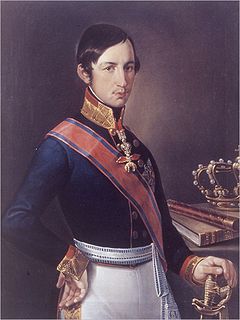
Francis V, Duke of Modena, Reggio and Guastalla, Archduke of Austria-Este, Royal Prince of Hungary and Bohemia, Duke of Mirandola and of Massa, Prince of Carrara was a reigning prince. He was Duke of Modena, Reggio, and Mirandola, Duke of Guastalla from 1847 and Duke of Massa and Prince of Carrara from 1846 to 1859. His parents were Francis IV of Modena and Princess Maria Beatrice of Savoy. He was the last reigning Duke of Modena before the duchy was incorporated into the Kingdom of Italy.

The Duchy of Massa was the duchy that controlled the towns of Massa and Carrara; the area is now part of unified Italy, but retains its local identity as the province of Massa-Carrara.

Pier Jacopo Alari Bonacolsi, called L'Antico by his contemporaries for the refined interpretation of the Antique they recognized in his work, was a 15th- and 16th-century North Italian sculptor, known for his finely detailed small bronzes all'Antica—coolly classicizing, often with gilded details, and silver-inlaid eyes, a refinement that is found in some classical and Hellenistic Greek bronzes.

Francesco II d'Este was Duke of Modena and Reggio from 1662 to 1694.

Boy with Thorn, also called Fedele (Fedelino) or Spinario, is a Greco-Roman Hellenistic bronze sculpture of a boy withdrawing a thorn from the sole of his foot, now in the Palazzo dei Conservatori, Rome. There is a Roman marble version of this subject from the Medici collections in a corridor of the Uffizi Gallery, Florence.

Francesco I d'Este was Duke of Modena and Reggio from 1629 until his death. The eldest son of Alfonso III d'Este, he became reigning duke after his father's abdication.

Francesco Farnese reigned as the seventh Farnese Duke of Parma and Piacenza from 1694 until his death. Married to Dorothea Sophia of the Palatinate, his brother Odoardo's widow, to avoid the return of her dowry, Francesco curtailed court expenditure, enormous under his father and predecessor, Ranuccio II, while preventing the occupation of his Duchy of Parma, nominally a Papal fief, during the War of the Spanish Succession.
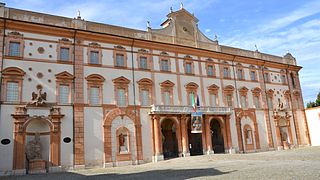
The Ducal Palace in Sassuolo is a Baroque villa located in the town of Sassuolo, thirty minutes outside Modena, northern Italy.
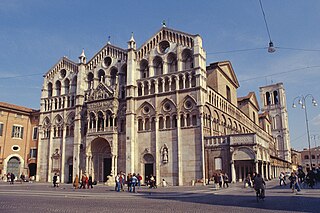
Ferrara Cathedral is a Roman Catholic cathedral and minor basilica in Ferrara, Northern Italy. Dedicated to Saint George, the patron saint of the city, it is the seat of the Archbishop of Ferrara and the largest religious building in the city.

A lapidarium is a place where stone monuments and fragments of archaeological interest are exhibited.

The Galleria Estense is an art gallery in the heart of Modena, centred around the collection of the d’Este family: rulers of Modena, Ferrara and Reggio from 1289 to 1796. Located on the top floor of the Palazzo dei Musei, on the St. Augustine square, the museum showcases a vast array of works ranging from fresco and oil painting to marble, polychrome and terracotta sculpture; musical instruments; numismatics; curios and decorative antiques.
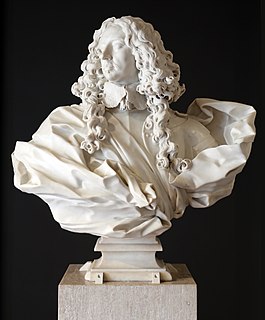
The Bust of Francesco I d'Este is a marble portrait bust by the Italian sculptor Gian Lorenzo Bernini. Completed in 1652, the work depicts Francesco I d'Este, Duke of Modena. It is in the Museo Estense, Modena, Italy. The noble yet detached expression of the face, the extensive drapery and the lavish locks of hair are often taken to be emblematic of the way Bernini represented "absolute monarchs" as seemingly adopting superior poses, oblivious to their surroundings. A painting of the portrait bust, surrounded by various objects, undertaken by the artist Francesco Stringa in the late 1660s is in the Minneapolis Institute of Art.
Adeodato Malatesta was an Italian painter, trained in a grand Neoclassical style, depicting mostly of sacred and historic subjects.
The Gallerie Estensi is a network of three museums and a library, bringing together the collective fruits of artistic production from Ferrara, Modena and Sassuolo in the Emilia-Romagna region of Northern Italy. The galleries aim to preserve the historic heritage left by the influential House of Este, with a focus on relating their noble past to the local communities at each site.

The Pinacotecta Nazionale is an art gallery in Ferrara, Emilia-Romagna, Italy. It is located on the piano nobile of the Palazzo dei Diamanti, a work of Renaissance architecture by Biagio Rossetti, commissioned by Leonello d’Este in 1447. Not to be confused with the Civic Museum on the lower floor, which has hosted temporary exhibitions of contemporary art since 1992, the Pinacoteca houses a collection of paintings by the Ferrarese School dating from the thirteenth to the eighteenth centuries. It was founded in 1836 by the Municipality of Ferrara after Napoleon's widespread dissolution of churches threatened the protection of important public artworks. The gallery is formed as much around notable northern Italian painters as it is around the exquisite interior decoration of the palace itself, together with remnants of frescoes from local churches and later acquisitions from the Sacrati Strozzi collection.

The Castle of the Pico is a castle in the city center of Mirandola, in the province of Modena, Italy.
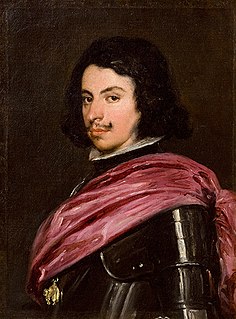
Portrait of Francesco I d'Este is a 1638-1639 oil on canvas portrait of Francesco I d'Este, Duke of Modena by Diego Velázquez, commissioned for the Este collection and still in the Galleria Estense in Modena.




















